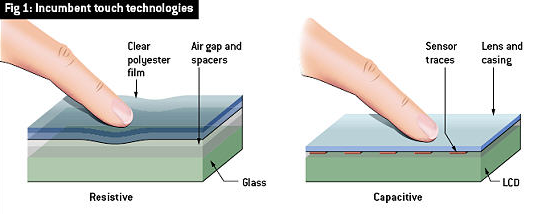By Nicole DiGiose
It's quite rare to come across a mobile device without a touchscreen these days. From smartphones to tablets to personal computers, touchscreen technology is used in most electronic devices. But before purchasing that new phone or tablet, be aware that there are two types of technology predominantly used in touch-sensitive computer devices: resistive and capacitive.
Resistive Touchscreen
A resistive touchscreen works the way you would expect a touch-sensitive screen to work—by sensing pressure. Its touchscreen panel is made of several layers, the most important being two electrically-resistive layers separated by an air gap. The top layer, which flexes under your finger, is pushed back onto the layer behind it, completing a circuit and telling the device which part of the screen is being pressed. A resistive touchscreen can also sense the touch of objects other than your finger, such as a stylus, as the sensing is dependent on pressure applied to the screen.
Capacitive Touchscreen
Instead of relying on pressure, a capacitive touchscreen uses electrodes to sense the conductive properties of an object, such as your finger. Compared to a resistive touchscreen, this results in smoother operation. This type of screen is much more sensitive than its resistive counterpart, so even a light swipe from the tip of your finger is enough to generate a response. But if you were to poke this touchscreen with a standard stylus, you'd get nowhere. Because the coating of its glass panel basically holds an electrical charge, capacitive touchscreens only respond to certain objects.

Image via gadgetchip.com.
So which is the better option? Though resistive touchscreens are cheaper, more versatile, and usually quite responsive, capacitive touchscreens, without a flexible top layer, seem to be more durable and user-friendly. When using a finger, they're much more responsive. Swiping, scrolling, zooming in or out, texting and typing e-mails are better suited to capacitive touchscreens.
Agree? Disagree? Leave your opinions in the comments section below.
For more information on touch displays and products such as LCD touch panels, TFT touch panels, and touch technology kits, visit Mouser’s Touch Technology website.
Advertisement
Learn more about Mouser Electronics





